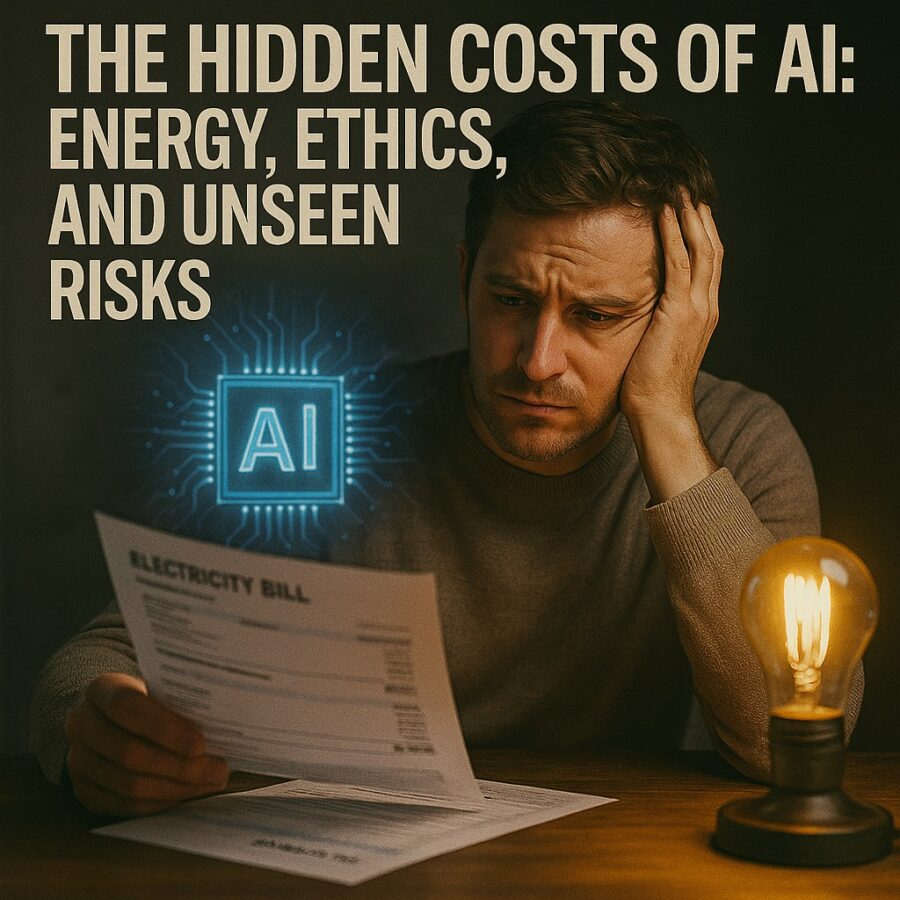Views: 2
Artificial intelligence has become a defining technology of the 21st century. It powers voice assistants, predicts consumer behavior, designs products, and generates art. The headlines usually focus on benefits: efficiency, creativity, and innovation. Yet beneath the surface lies a sobering reality. The hidden costs of AI stretch far beyond price tags or cloud subscriptions. They involve energy consumption, ethical dilemmas, and risks often ignored in the race to innovate.
This article unpacks those costs, exploring their implications for society and the environment while asking how we might navigate toward a more responsible future.
Energy Consumption and the Environmental Toll
Training large-scale AI models requires vast computational power. A single model can consume as much energy as hundreds of households use in a year. Running these models continuously for real-time applications adds to the load.
The energy demand contributes to carbon emissions when fueled by non-renewable sources. Data centers, often located in regions with inexpensive electricity, sometimes rely on coal or natural gas. Cooling systems further compound the problem.
This energy footprint is a prime example of the hidden costs of AI. What appears as a seamless chatbot interaction to the user masks an immense infrastructure drawing power behind the scenes. Without progress in energy-efficient chips and renewable energy adoption, the environmental price of artificial intelligence will only rise.
The Water Footprint of Data Centers
Beyond electricity, AI systems consume water. Data centers use millions of gallons daily for cooling servers. In drought-prone regions, this demand places additional stress on already limited water supplies.
Communities living near major facilities may face reduced access or rising costs as corporations compete for water resources. Public debate around this issue is growing, yet it remains an overlooked part of the hidden costs of AI.
The following is a referral or affiliated link that AltPenguin receives compensation for, should the link be used and the offer is completed. To provide full transparency, we at AltPenguin are stating this before you click the image below (the image will open a new page to the offer shown in the image).
The Ethical Dilemma of Data Use
AI thrives on data. From images to personal information, models require massive datasets to train effectively. But where does this data come from? Much of it is scraped from the internet without explicit consent. Artists, writers, and everyday users often find their work or profiles repurposed for machine learning without awareness.
This raises profound ethical questions. Ownership, compensation, and consent are often bypassed in the rush to build bigger models. Critics argue that the hidden costs of AI include eroding privacy rights and exploiting creative labor. The technology industry must grapple with whether innovation justifies these practices or if new standards of accountability are required.
Labor and Human Oversight
Despite automation, AI still relies heavily on human labor. Workers in developing countries often perform the invisible tasks of labeling data, moderating content, and training models to identify harmful material. These jobs are low-paying, repetitive, and emotionally taxing.
The existence of this hidden workforce challenges the narrative of fully automated intelligence. It underscores how the hidden costs of AI extend to human well-being, where invisible labor props up the appearance of seamless machine performance.
Bias and Inequality
Another cost arises from algorithmic bias. Models trained on unrepresentative data inherit and amplify prejudices. Facial recognition systems have shown higher error rates for women and people of color. Predictive policing algorithms sometimes reinforce racial disparities.
These biases have real-world consequences, affecting employment, education, healthcare, and criminal justice. The persistence of such flaws illustrates how the hidden costs of AI can worsen inequality unless addressed with careful oversight and inclusive design.
The Risk of Overreliance
AI is often marketed as objective and reliable, yet overreliance poses risks. When institutions delegate critical decisions to opaque systems, accountability diminishes. Consider a bank using an AI credit-scoring model. If the system denies a loan, who is responsible: the bank, the engineers, or the algorithm itself?
This diffusion of responsibility is another dimension of the hidden costs of AI. Humans may abdicate judgment, assuming machines are neutral, when in reality, every model reflects choices about data, design, and values.
Security and Malicious Use
Artificial intelligence does not only serve constructive purposes. The same generative tools that create essays and images can also produce misinformation, deepfakes, and malicious code.
Cybercriminals are beginning to use AI to craft convincing phishing attacks or bypass security systems. Nations worry about the potential of AI-driven cyberwarfare. These threats illustrate how the hidden costs of AI include not only unintended side effects but also deliberate exploitation by bad actors.
The following is a referral or affiliated link that AltPenguin receives compensation for, should the link be used and the offer is completed. To provide full transparency, we at AltPenguin are stating this before you click the image below (the image will open a new page to the offer shown in the image).
Economic Disruption
The labor market impact of AI is difficult to predict. Some argue that new jobs will offset losses, as with past technological shifts. Others warn of significant displacement, particularly in white-collar sectors such as law, finance, and customer service.
Even if new roles emerge, the transition period could bring inequality and hardship. Workers may lack the resources to retrain quickly enough to adapt. This turbulence forms part of the hidden costs of AI, where societies absorb disruption in the name of progress.
Governance and Regulation Challenges
Governments worldwide struggle to regulate artificial intelligence. The technology advances faster than legislative processes, leaving gaps in oversight. Laws designed for the internet or social media often fail to address the complexity of machine learning systems.
Without clear standards, companies pursue innovation unchecked, creating risks for consumers and institutions alike. The effort to establish guardrails highlights how the hidden costs of AI involve governance failures as much as technical ones.
Psychological and Social Impacts
AI not only influences industries but also shapes culture. Generative systems raise questions about authenticity in art, music, and writing. Social media algorithms driven by AI affect attention spans, self-image, and mental health, particularly among youth.
As society grows accustomed to AI-driven personalization, individuals may struggle with overexposure to curated information. This creates echo chambers and weakens democratic discourse. These consequences are part of the hidden costs of AI, shaping not only economics but human psychology.
The Problem of Transparency
Transparency is often touted as a solution, but it remains elusive. Many models are black boxes. Even developers cannot fully explain how outputs are generated. This lack of interpretability undermines trust and prevents users from challenging decisions.
When systems control credit approvals, medical recommendations, or parole evaluations, opacity becomes dangerous. The lack of transparency reinforces why the hidden costs of AI cannot be overlooked in discussions of accountability.
Possible Solutions and Mitigation
The presence of costs does not mean artificial intelligence should be abandoned. Instead, it calls for responsible innovation.
- Energy efficiency: Research into specialized chips and renewable energy adoption can reduce environmental impact.
- Ethical data sourcing: Clear guidelines for consent and compensation can protect creators and users.
- Fair labor practices: Companies can ensure workers labeling data receive fair wages and support.
- Bias audits: Independent evaluations can identify and correct harmful patterns.
- Regulation: Governments can establish flexible but enforceable rules to safeguard society without stifling innovation.
By addressing these areas, the narrative of the hidden costs of AI can shift from inevitability to opportunity for reform.
The Role of Public Awareness
Public understanding plays a vital role in shaping outcomes. When consumers demand transparency and sustainability, companies respond. When citizens push for regulation, policymakers act. Educated awareness of the unseen risks ensures accountability.
Discussing the hidden costs of AI openly in schools, media, and workplaces fosters the cultural pressure needed to guide technology responsibly.
Looking Ahead
Artificial intelligence will only grow more integrated into daily life. The challenge is ensuring that its benefits do not obscure its dangers. Progress requires acknowledging energy demands, labor exploitation, bias, and governance gaps.
The question is not whether society can afford AI but whether it can afford to ignore its hidden costs. By confronting energy, ethics, and risks now, we increase the chance that AI becomes a tool for collective good rather than a source of unchecked harm.
The following is a referral or affiliated link that AltPenguin receives compensation for, should the link be used and the offer is completed. To provide full transparency, we at AltPenguin are stating this before you click the image below (the image will open a new page to the offer shown in the image).
Closing Thoughts
Artificial intelligence is often described as a revolution. Like revolutions before it, the promise comes with price. The hidden costs of AI remind us that progress is not free. They include environmental burdens, ethical dilemmas, economic disruption, and cultural shifts.
Recognizing these costs does not mean rejecting AI. It means engaging with it critically, responsibly, and transparently. The road ahead requires balancing innovation with stewardship, ensuring technology serves humanity rather than undermines it.
The future of AI will be defined not just by what it can do, but by how wisely we manage the unseen risks that accompany its rise.




](https://altpenguin.com/wp-content/uploads/2025/08/veed-ad.webp)
